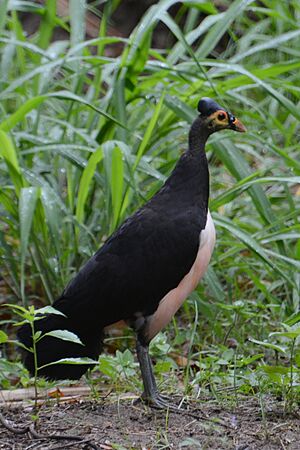Maleo facts for kids
Quick facts for kids Maleo |
|
|---|---|
 |
|
| Conservation status | |
| Scientific classification | |
| Genus: |
Macrocephalon
|
| Species: |
maleo
|
The maleo (Macrocephalon maleo) is a unique bird that belongs to a group called megapodes. It's the only species in its special group, Macrocephalon. This bird lives only on the Indonesian island of Sulawesi and a smaller island nearby called Buton. Maleos live in warm, tropical forests, but they lay their eggs in open, sandy spots. These nesting areas are often heated by the sun or by natural heat from the Earth, like volcanic soils. This natural heat helps to warm their eggs.
Contents
What Does a Maleo Look Like?
The maleo is a medium-sized bird, about 55 to 60 centimeters (21 to 24 inches) long. It has mostly black feathers. Its face is bare and yellow, and its eyes have a reddish-brown color. The beak is reddish-orange, and its belly is a pretty rosy salmon color.
One cool thing about the maleo is the big, bony bump on its head. This bump is called a casque. The bird's scientific name, Macrocephalon, means "large head" in Greek, which makes sense because of this casque! Its feet are grayish-blue with four long, sharp claws. A thin web connects the toes. Male and female maleos look very similar, but the female is usually a bit smaller and her colors are not as bright. Young maleos have brownish heads and duller colors overall.
Maleo Behavior and Life Cycle
Maleos are monogamous, which means a male and female pair stay together for life. They usually stay very close to each other. Their diet includes fruits, seeds, and small creatures like mollusks, ants, termites, beetles, and other tiny invertebrates.
How Maleos Lay Their Eggs
Maleo eggs are huge! They are about five times bigger than a chicken's egg. When a female maleo is ready to lay an egg, she and her mate will leave the forest. They look for special nesting spots on riverbanks, lake shores, or beaches. These spots are often used by many maleo pairs, making them communal nesting grounds.
The female digs a deep hole in the sand, sometimes covering it with other things to hide it. She then lays her egg inside. After the egg is buried, the parents leave and never come back. This means the baby maleo chick is on its own from the moment it hatches!
Hatching and Growing Up
The hot sand acts like an incubator for the maleo eggs, keeping them warm with heat from the sun or from underground volcanoes. Because the parents don't help, the baby maleo inside the egg is almost fully developed when it hatches.
Once it hatches, the chick has to dig its way out of the sand. This can take a few hours. As soon as it's out, it can fly and find its own food! It also has to protect itself from predators like monitor lizards, large snakes called reticulated pythons, wild pigs, and cats.
Where Maleos Live
Maleos are only found on the island of Sulawesi in Indonesia. They usually live in lowland forests or hills, but not higher than 1,000 meters (about 3,300 feet) above sea level. They breed all year, but the busiest time for laying eggs can be different depending on the location on the island.
Threats and Conservation Efforts
Sadly, the maleo is a critically endangered bird. This means it's at a very high risk of disappearing forever. Many of their old nesting sites are now empty because people have been taking their eggs or changing the land for farming. Out of 142 known nesting areas, only 4 are considered safe today.
The forests where maleos live are also shrinking and breaking into smaller pieces. This makes it harder for the birds to find good homes. Big Wildfires in 2000 and 2004 destroyed large areas of forest, and the new plants that grew back were not suitable for maleos. Also, as towns grow, it's becoming harder and more dangerous for maleos to travel between their forest homes and the coastal areas where they lay eggs.
Protecting the Maleo
The Indonesian government has protected the maleo since 1972. Experts believe there are only about 4,000 to 7,000 breeding pairs left in the wild, and their numbers are still going down quickly. Because of these threats, the maleo is listed as critically endangered by the IUCN Red List of Threatened Species. It's also on Appendix I of CITES, which means international trade of these birds is banned.
Many groups are working to help the maleo. In 2009, the US-based Wildlife Conservation Society bought a piece of beach property in Indonesia to protect about 40 maleo nests. The Alliance for Tompotika Conservation also works with local communities in Sulawesi. They teach people about the maleo's endangered status and try to stop the collection of their eggs. Maleo eggs are not a main food source, but they are sometimes taken as a special treat.
Maleos in Zoos
The Bronx Zoo in New York and the Nashville Zoo are some of the only places outside of Indonesia where you can see maleos. They are working to breed these birds to help increase their numbers. A breeding pair of maleos at the Bronx Zoo was even featured on the Animal Planet show The Zoo. A senior keeper, Alana O'Sullivan, talked about the birds and the dangers they face. She also mentioned that many people don't even know these amazing birds exist.
Maleos have a fancy courtship dance, and they love peanuts! Keepers can tell when a female is about to lay an egg because she loses interest in everything, even her favorite peanuts. This tells the keepers that an egg will be laid within 24 hours.


